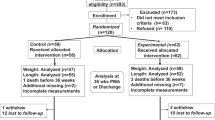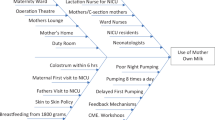Abstract
Background/Objectives:
Low birth weight (LBW), defined as the body weight at birth of less than 2500 g, is a major public health problem in Bangladesh, where 37% of the babies are born with LBW. The objective of this study is to see the impact of nutrition education on growth of LBW babies with early initiation and exclusive breastfeeding compared to control group.
Subjects/Methods:
A total of 184 LBW babies and their mothers who attended the Maternal Care and Health Training Institute and Dhaka Medical College Hospital were randomly allocated to either intervention or control group. Enrollment of the study population started in May 2008 and was completed in October 2008. Nutrition education was given to mothers twice weekly for 2 months, on initiation of breastfeeding within 1 h, exclusive breastfeeding and increasing their dietary intake. Nutritional status of LBW babies was assessed for length and weight every 2 weeks. Data were analyzed using SPSS/Window's version 12. Comparison of mean of data was done using standard Student's t-test.
Results:
Mean initial body weight and length of LBW babies were similar in both groups (2261±198 g vs 2241±244 g, P=0.535 and 43.0±1.3 cm vs 43.0±1.7 cm, P=0.77). Body weight and length of the LBW babies after 2 months increased significantly (3620±229 g vs 3315±301 g, P<0.001 and 50.2±1.3 cm vs 48.7±1.6 cm, P<0.001). It was found that the intervention group suffered less from respiratory illness compared with the control group (39% vs 66%, P<0.001). The rate of early initiation of breastfeeding was also significantly higher with nutrition intervention (59.8% vs 37.2%, P<0.001). Exclusive breastfeeding rate was significantly higher in intervention group (59.8% vs 37%, P=0.003).
Conclusions:
The present study showed that weight and length gain of LBW babies significantly increased by breastfeeding and nutrition education. Therefore, nutrition education on breastfeeding proves to be a strong tool to reduce the high risk of malnutrition and mortality of the LBW babies.
This is a preview of subscription content, access via your institution
Access options
Subscribe to this journal
Receive 12 print issues and online access
$259.00 per year
only $21.58 per issue
Buy this article
- Purchase on Springer Link
- Instant access to full article PDF
Prices may be subject to local taxes which are calculated during checkout
Similar content being viewed by others
References
Adair LS, Popkin BM (1996). Low birth weight reduces the likelihood of breast-feeding among Filipino infants. J Nutr 126, 103.
Agarwal S, Karmaus W, Davis S, Gangur V (2011). Immune markers in breast milk and fetal and maternal body fluids: a systematic review of perinatal concentrations. J Hum Lact 27, 171–186.
Ahmed T, Roy SK, Alam N, Ahmed AMS, Ara G, Bhuiya AU et al. (2005). National Nutrition Programme, Baseline Survey 2004.
Alexander GR, Korenbrot CC (1995). The role of prenatal care in preventing low birth weight. Future Child 5, 103–120.
Alive and Thrive (2010). Impact of early initiation of exclusive breastfeeding on newborn deaths: 3.
American Academy of Pediatrics (2005). Breastfeeding and the use of human milk, Policy Statement, organizational principles to guide and define the child health care system and/or improve the health of all children. Pediatrics 115, 496–506.
Ashworth A (1998). Effects of intrauterine growth retardation on mortality and morbidity in infants and young children. Eur J Clin Nutr 52, 34–42.
Baker EJ, Sanei LC, Franklin N (2006). Early initiation of and exclusive breastfeeding in large-scale community-based programmes in Bolivia and Madagascar. J Health Popul Nutr 24, 530.
Bangladesh Govt. (2009). Bangladesh Demographic and Health Survey 2007. N Mitra and Associates: Dhaka and Macro International Calverton, Maryland, USA.
Black RE, Allen LH, Bhutta ZA, Caulfield LE, de Onis M, Ezzati M et al. (2008). Maternal and child undernutrition: global and regional exposures and health consequences. Lancet 371, 243–260.
Edmond KM, Zandoh C, Quigley MA, Amenga-Etego S, Owusu-Agyei S, Kirkwood BR (2006). Delayed breastfeeding initiation increases risk of neonatal mortality. Pediatrics 117, e380.
Goyal RC, Banginwar AS, Ziyo F, Toweir AA (2011). Breastfeeding practices: positioning, attachment (latch-on) and effective suckling - a hospital-based study in Libya. J Family Community Med 18, 74–79.
Gunnarsdottir I, Schack-Nielsen L, Michaelsen KF, Sørensen TIA, Thorsdottir I (2009). Infant weight gain, duration of exclusive breast-feeding and childhood BMI–two similar follow-up cohorts. Public Health Nutr 13, 201–207.
Gupta RK (2008). Care of low birth weight neonates. JK Sci J Med Edu Res 10, 158–159.
Haseen F (2005). Malnutrition among Bangladeshi women in ultra poor households: prevalence and determinants. Retrieved September 20, 2006.
Haughton B, Costello C, Traylor MN, Reeves K (1992). Public health nutrition practices to prevent low birth weight in eight southeastern states. J Am Diet Assoc 92, 187–191.
Jones G, Steketee RW, Black RE, Bhutta ZA, Morris SS (2003). How many child deaths can we prevent this year? Lancet 362, 65–71.
Kalies H, Heinrich J, Borte M, Schaaf B, von Berg A, von Kries R et al. (2005). The effect of breastfeeding on weight gain in infants: results of a birth cohort study. Eur J Med Res 10, 36–37.
Kelley L, Pojda J (2000). Low Birth weight, Nutrition Policy Paper No. 18.
Kramer MS (1987). Intrauterine growth and gestational duration determinants. Pediatrics 80, 502.
LancetSeries (2009). The Lancet's series on maternal and child undernutrition. Lancet Executive Summary, 3.
Lauer JA, Betrán AP, Barros AJD, De Onis M (2007). Deaths and years of life lost due to suboptimal breast-feeding among children in the developing world: a global ecological risk assessment. Public Health Nutr 9, 673–685.
Lopez-Alarcon M, Villalpando S, Fajardo A (1997). Breast-feeding lowers the frequency and duration of acute respiratory infection and diarrhea in infants under six months of age. J Nutr 127, 436.
Moster D, Lie RT, Markestad T (2008). Long-term medical and social consequences of preterm birth. N Engl J Med 359, 262.
Mullany LC, Katz J, Li YM, Khatry SK, LeClerq SC, Darmstadt GL et al. (2008). Breast-feeding patterns, time to initiation, and mortality risk among newborns in southern Nepal. J Nutr 138, 599.
Nahar N, Afroza S, Hossain M (1998). Incidence of low birth weight in three selected communities of Bangladesh. Bangladesh Med Res Council Bull 24, 49.
Nakao Y, Moji K, Honda S, Oishi K (2008). Initiation of breastfeeding within 120 minutes after birth is associated with breastfeeding at four months among Japanese women: a self-administered questionnaire survey. Int Breastfeed J 3, 1.
Nohr EA, Vaeth M, Baker JL, Sorensen TIA, Olsen J, Rasmussen KM (2008). Combined associations of prepregnancy body mass index and gestational weight gain with the outcome of pregnancy. Am J Clin Nutr 87, 1750.
Perera BJC, Ganesan S, Jayarasa J, Ranaweera S (1999). The impact of breastfeeding practices on respiratory and diarrhoeal disease in infancy: a study from Sri Lanka. J Trop Pediatr 45, 115.
Ramakrishnan U (2004). Nutrition and low birth weight: from research to practice1–5. Am J Clin Nutr 79, 17–21.
Salam A, Haseen F, Yusuf HKM, Torlesse H, Icddr B (2004). National low birth-weight survey of Bangladesh, 2003–2004. Prevention 76, 155.
Singh D, Devi N, Raman TSR (2009). Exclusive breast feeding in low birth weight babies. Med J Armed Forces India 65, 208.
Siva Subramanian KN, Barton AM, Montazami S, Cassady G, Windle ML, Carter BS (2011). Extremely Low Birth Weight Infant Ted Rosenkrantz, 2011.
Sur D, Mondal SK, Gupta DN, Ghosh S, Manna B, Sengupta PG (2001). Impact of breastfeeding on weight gain and incidence of diarrhea among low birth weight infants of an urban slum of Calcutta. Indian Pediatr 38, 381.
UNICEF, WHO (2004). Low Birth Weight, Country, Regional and Global estimates.
UNICEF (2008). Nutrition, Breastfeeding.
Victora CG, Adair L, Fall C, Hallal PC, Martorell R, Richter L et al. (2008). Maternal and child undernutrition: consequences for adult health and human capital. Lancet 371, 340–357.
Viswanathan M, Siega-Riz AM, Moos MK, Deierlein A, Mumford S, Knaack J et al. (2008). Outcomes of maternal weight gain. Evid Rep Technol Assess 168, 1–223.
WHO Collaborative Study Team on the Role of Breastfeeding on the Prevention of Infant Mortality (2000). Effect of breastfeeding on infant and child mortality due to infectious diseases in less developed countries: a pooled analysis. Lancet 355, 451–455.
WHO (2010). The WHO Child Growth Standards.
WHO (2006). WHO Multicentre Growth Reference Study Group, WHO Child Growth Standards based on length/height, weight and age. Acta Paediatrica 450, 76–85.
World Health Organization (2009). Infant and Young Child Feeding.
World Health Organization (2008). Optimal duration of exclusive breastfeeding: The WHO Reproductive Health Library, 2008.
Yasmin S, Osrin D, Paul E, Costello A (2001). Neonatal mortality of low-birth-weight infants in Bangladesh. Bull World Health Organ 79, 608–614.
Zaman K, Baqui AH (1997). Acute respiratory infections in children: a community-based longitudinal study in rural Bangladesh. J Trop Pediatr 43, 133.
Author information
Authors and Affiliations
Corresponding author
Ethics declarations
Competing interests
The authors declare no conflict of interest.
Rights and permissions
About this article
Cite this article
Thakur, S., Roy, S., Paul, K. et al. Effect of nutrition education on exclusive breastfeeding for nutritional outcome of low birth weight babies. Eur J Clin Nutr 66, 376–381 (2012). https://doi.org/10.1038/ejcn.2011.182
Received:
Revised:
Accepted:
Published:
Issue Date:
DOI: https://doi.org/10.1038/ejcn.2011.182
Keywords
This article is cited by
-
Counselling interventions to enable women to initiate and continue breastfeeding: a systematic review and meta-analysis
International Breastfeeding Journal (2019)
-
Secondhand Smoke Exposure During Pregnancy and Mothers’ Subsequent Breastfeeding Outcomes: A Systematic Review and Meta-Analysis
Scientific Reports (2019)
-
Intervention based on BASNEF model increases exclusive breastfeeding in preterm infants in Iran: a randomized controlled trial
International Breastfeeding Journal (2016)
-
Postnatal lactational counseling and neonatal weight pattern
Indian Pediatrics (2015)
-
Recognition and home care of low birth weight neonates: a qualitative study of knowledge, beliefs and practices of mothers in Iganga-Mayuge Health and Demographic Surveillance Site, Uganda
BMC Public Health (2014)



